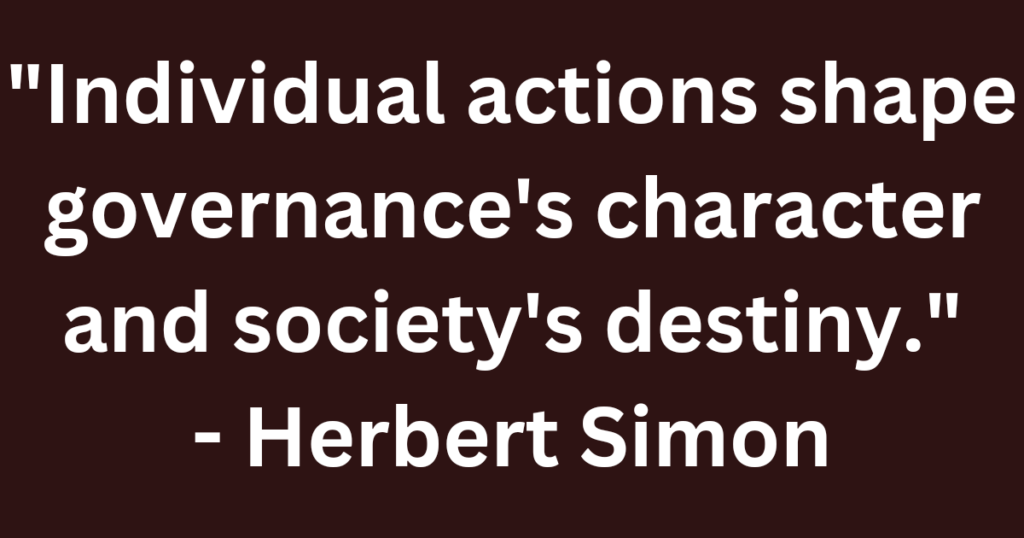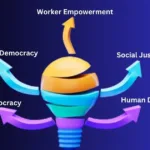Behavioral Approach to Public Administration is modern approach in public Administration. The effective functioning of governments and public organizations hinges on the critical role played by public administration. This encompasses the management of public resources, the delivery of public services, and the implementation of policies. Throughout history, various approaches have emerged to guide the practice of public administration, each offering its unique principles and perspectives. One such approach is the behavioral approach, which centers on understanding human behavior and decision-making within the context of public administration. In this article, we will delve into the intricacies of the behavioral approach, exploring its historical evolution, theoretical foundations, and practical applications. By obtaining a comprehensive understanding of this approach, public administrators can leverage behavioral insights to enhance the efficiency and effectiveness of their administrative processes.
Defining Public Administration
Before we delve into the behavioral approach, let’s establish a foundational understanding of public administration. It involves the management and implementation of government policies and programs aimed at serving the public interest. This encompasses various activities, including planning, organizing, coordinating, and controlling the resources needed to deliver public services. Public administrators operate at different levels of government, ensuring the smooth functioning of public organizations and the delivery of essential services to citizens.
Introduction to the Behavioral Approach
The behavioral approach in public administration underscores the significance of human behavior, decision-making, and motivation in shaping administrative processes and outcomes. Unlike traditional approaches that emphasize structural and procedural aspects, the behavioral approach recognizes that individuals within the system are influenced not only by external factors but also by their cognitive processes, emotions, and motivations. Understanding these internal drivers allows public administrators to design interventions and policies that align with the realities of human behavior, increasing the likelihood of successful outcomes.
There are some definitions for better understandings to Behavioral Approach to Public Administration:
- Chester I. Barnard (1886–1961):
- Rephrased Definition: Chester Barnard’s interpretation of the Behavioral Approach underscores the importance of comprehending human behavior within organizational contexts. According to Barnard, effective administration requires an understanding of individual and group behaviors, recognizing the informal dynamics within organizations. This approach involves integrating insights into human behavior into administrative processes to enhance overall organizational efficiency.
2. Herbert A. Simon (1916–2001):
- Rephrased Definition: Herbert Simon’s Behavioral Approach in public administration signifies a departure from rigid rationality assumptions. Simon advocates for a realistic model that acknowledges the bounded rationality of decision-makers within organizations. This perspective recognizes that decisions are often made with limited information and cognitive resources, influencing administrative decisions and outcomes.
3. Douglas McGregor (1906–1964):
- Rephrased Definition: Douglas McGregor, through his Theory X and Theory Y framework, contributes to the Behavioral Approach by presenting contrasting views on employee motivation. Theory X assumes that individuals require external coercion due to inherent laziness, while Theory Y suggests that individuals are intrinsically motivated and seek fulfillment through work. McGregor’s insights highlight the role of management beliefs in shaping organizational behavior.
4. Chris Argyris (1923–2013):
- Rephrased Definition: Chris Argyris contributes to the Behavioral Approach by examining how organizational structures and management practices influence human behavior. Argyris emphasizes organizational learning and argues that effective administration necessitates environments fostering continuous learning, adaptability, and open expression of ideas, ultimately improving organizational effectiveness.
5. Mary Parker Follett (1868–1933):
- Rephrased Definition: Mary Parker Follett’s impact on the Behavioral Approach lies in her emphasis on integrating individual and collective behavior within administration. Follett advocates for a collaborative approach to decision-making and conflict resolution, where administrators recognize and leverage the inherent complexity of human relationships to foster harmonious and productive organizational environments.
Evolution of the Behavioral Approach in Public Administration

Historical Perspectives on Public Administration
The roots of the behavioral approach can be traced back to the mid-20th century when scholars began challenging the assumptions of traditional approaches to public administration. Traditional approaches predominantly focused on structural aspects, advocating for hierarchical decision-making and rigid bureaucratic processes. However, scholars like Chester Barnard and Herbert Simon questioned these perspectives, emphasizing the importance of human behavior in the administrative context. They argued that understanding human behavior was crucial for effective decision-making and organizational performance.
Key Principles of the Behavioral Approach to Public Administration
The behavioral approach is underpinned by several key principles that shape its application in public administration. These principles include a focus on individual behaviors and motivations, acknowledgment of cognitive limitations, use of incentives and rewards to influence behavior, and identification of social and psychological factors that shape decision-making processes. By embracing these principles, public administrators can develop interventions and policies that align with human behavior, increasing the likelihood of desired outcomes.
Importance of Applying Behavioral Insights in Public Administration
The application of the behavioral approach in public administration is of immense importance. By recognizing the complexities of human behavior and decision-making, public administrators can design policies and programs that are more likely to be effective in achieving their intended goals. For example, understanding the cognitive biases that individuals harbor can help administrators tailor information and communication strategies to ensure better comprehension and engagement. Additionally, incorporating incentives and rewards that resonate with individuals’ motivations can increase their compliance and participation in public programs.
Theoretical Foundations of the Behavioral Approach
The behavioral approach is rooted in various theoretical foundations, providing insights into human behavior, decision-making, and motivation. By examining these theories, public administrators can gain a deeper understanding of the factors influencing individuals’ actions and design interventions accordingly.
Human Behavior and Decision-Making
One of the foundational aspects of the behavioral approach lies in the study of human behavior and decision-making. Cognitive theory, for instance, explores the mental processes that individuals undergo when making decisions, recognizing that human decision-making is prone to biases, heuristics, and limited information processing abilities. Public administrators can use this knowledge to design decision-making processes that account for these cognitive limitations, promoting more rational and informed choices.
Behavioral Theories in Public Administration
In the context of public administration, several behavioral theories have been applied to understand and predict individual and collective behaviors. For example, the theory of planned behavior suggests that individuals’ intentions to engage in certain behaviors are influenced by their attitudes, subjective norms, and perceived behavioral control. Public administrators can leverage this theory to design persuasive campaigns that target individuals’ attitudes and social norms, aiming to influence their behavior in desired ways.
Understanding Motivation and Incentives
Motivation plays a crucial role in shaping human behavior, both in the public and private sectors. The behavioral approach to public administration acknowledges the importance of incentives and rewards in motivating individuals to act in certain ways. By understanding the underlying motivations of individuals, public administrators can design incentive structures that align with these motivations, encouraging desired behaviors. This can range from providing financial rewards for achieving specific goals to designing recognition systems that tap into individuals’ need for social status and appreciation.
Behavioral Approaches in Public Policy Design and Implementation

The integration of behavioral insights in public policy design and implementation has gained significant traction in recent years. By incorporating the principles of behavioral economics, policymakers can improve the effectiveness of public interventions and achieve better outcomes for citizens.
Behavioral Economics in Public Policy
Behavioral economics combines insights from economics and psychology to understand how individuals make decisions and respond to incentives. In public policy, this approach recognizes that individuals do not always act rationally and are prone to cognitive biases. By leveraging these insights, public administrators can nudge individuals towards more beneficial behaviors, improving the outcomes of public policies. For example, framing certain choices in a particular way can influence individuals’ decision-making, leading to desired behavioral changes.
Nudging for Better Outcomes
Nudging refers to the use of subtle interventions that guide individuals’ behavior without restricting their freedom of choice. This approach has gained popularity in public policy due to its effectiveness in influencing behavior while respecting individuals’ autonomy. Public administrators can employ nudges to encourage citizens to engage in actions that promote public well-being. For instance, placing healthy food options at eye level in school cafeterias or automatically enrolling individuals in retirement plans can significantly impact their choices in beneficial ways.
Behavioral Insights for Effective Governance
In addition to policy design, behavioral insights can also be applied to improve the governance and delivery of public services. By considering the behavioral aspects of service delivery, public administrators can design processes that are more user-friendly, efficient, and responsive to citizens’ needs. This can include simplifying complex procedures, incorporating defaults that simplify decision-making, or utilizing social norms to encourage compliance with regulations.
Organizational Behavior and Leadership in Public Administration
Understanding and managing organizational behavior is essential for effective public administration. The behavioral approach provides valuable insights into the dynamics of organizations and the role of leadership in shaping employee behavior and organizational outcomes.
Understanding Organizational Behavior
Organizational behavior is the study of how individuals, groups, and structures interact within an organization. By examining the social and psychological factors that influence behavior within organizations, public administrators can gain a deeper understanding of the dynamics that impact administrative processes. This understanding can help administrators optimize organizational structures, foster a positive work environment, and improve overall performance.
Leadership Styles and Their Impact
Leadership styles play a crucial role in shaping employee behavior and organizational culture. The behavioral approach to public administration recognizes that different leadership styles have varying effects on employee motivation, job satisfaction, and overall organizational performance. By understanding the strengths and limitations of different leadership styles, public administrators can adopt approaches that align with the specific needs of their organizations and promote positive outcomes.
Behavioral Strategies for Effective Public Leadership
Public leaders can leverage behavioral strategies to enhance their effectiveness in guiding organizations and achieving desired outcomes. These strategies may include fostering a supportive organizational culture that aligns with the values and goals of the administration, promoting open communication channels, empowering employees through participation in decision-making processes, and recognizing and rewarding high performance. By adopting these behavioral strategies, public leaders can create an environment that encourages innovation, collaboration, and continuous improvement.
Challenges and Limitations of Behavioral Approach in Public Administration

While the behavioral approach offers valuable insights and strategies, it also presents its own set of challenges and limitations that need to be considered by public administrators.
Ethical Considerations
Applying the behavioral approach in public administration raises ethical questions regarding manipulating individuals’ behavior. Public administrators must carefully assess the ethical implications of interventions that seek to influence behavior, ensuring that they respect individuals’ autonomy, privacy, and rights. Striking the right balance between behavioral insights and ethical considerations is crucial to maintaining public trust and legitimacy.
Implementation Challenges
Implementing the behavioral approach in public administration can encounter various challenges. These challenges may include resistance to change from bureaucratic systems, the need for specialized expertise and resources, and the potential for unintended consequences. Public administrators must navigate these challenges to successfully integrate behavioral insights into their administrative practices, ensuring an effective and sustainable implementation.
Balancing Behavioral and Traditional Approaches
While the behavioral approach offers valuable perspectives, it is essential to recognize that it should not completely replace traditional approaches in public administration. A balanced approach that integrates both behavioral insights and traditional practices can yield the best results. Public administrators need to strike a balance between the two approaches, leveraging the strengths of each while mitigating their respective limitations. This requires careful consideration and adaptation based on the specific context and objectives of public administration.
Criticisms of the Behavioral Approach in Public Administration from various perspectives:
- Luther Gulick (1892–1993):
- Criticisms: Gulick criticized the Behavioral Approach for its tendency to downplay the significance of organizational structures and hierarchies. He argued that an exclusive focus on individual and group behavior might neglect the importance of clearly defined roles, responsibilities, and formal organizational arrangements, which are vital for maintaining order and efficiency within public administration.
2. James Q. Wilson (1931–2012):
- Criticisms: Wilson expressed concerns about the Behavioral Approach’s potential lack of practical utility in policy implementation. He argued that an exclusive emphasis on understanding human behavior might not provide concrete guidance for policymakers in addressing complex issues and making effective decisions, leading to a gap between theoretical insights and practical application.
3. John W. Gardner (1912–2002):
- Criticisms: Gardner criticized the Behavioral Approach for its limited attention to the political dimensions of public administration. He argued that the approach often sidelines the influence of political factors on administrative decisions and actions, overlooking the intricate interplay between bureaucratic structures and political dynamics within the public sector.
4. David Easton (1917–2014):
- Criticisms: Easton raised concerns about the Behavioral Approach’s potential to oversimplify the relationship between administrators and the broader political environment. He argued that the approach might not adequately address the complex interdependencies and feedback loops between administrative actions and the political system, leading to a less nuanced understanding of the administrative-political interface.
5. Paul Appleby (1891–1974):
- Criticisms: Appleby criticized the Behavioral Approach for its tendency to understate the importance of accountability and control mechanisms within public administration. He argued that an excessive focus on behavioral aspects might undermine the need for clear lines of accountability, checks and balances, and transparency, which are crucial for ensuring the responsible exercise of administrative power.
People Also Read : Public Administration and It’s Meaning, Definition, Features & Purpose
Key Advantages Behavioral Approach to Public Administration:

- Enhanced Understanding of Human Behavior:
- The Behavioral Approach provides a deeper insight into individual and group behavior within the administrative context. This understanding is crucial for public administrators to navigate the complexities of human interactions, decision-making processes, and motivations, leading to more informed and effective administrative practices.
2. Improved Decision-Making Processes:
- By incorporating insights from behavioral studies, public administrators can enhance decision-making processes. Recognizing cognitive biases, emotional influences, and social factors allows for the development of decision-making strategies that account for these elements, leading to more rational and well-informed choices.
3. Tailored Policies and Programs:
- Behavioral insights enable the customization of policies and programs to align with the realities of human behavior. Public administrators can design interventions that consider the motivations, perceptions, and cognitive processes of individuals, increasing the likelihood of successful policy implementation and achieving desired outcomes.
4. Effective Communication and Engagement:
- Understanding behavioral patterns facilitates more effective communication strategies. Public administrators can tailor their communication to resonate with the preferences and cognitive processes of their audience, leading to better comprehension, engagement, and public participation in administrative initiatives.
5. Motivation and Employee Engagement:
- In the context of public organizations, the Behavioral Approach recognizes the importance of motivation in shaping employee behavior. Public administrators can use insights into human motivation to design incentive structures, recognition programs, and leadership approaches that foster employee engagement, satisfaction, and overall organizational performance.
6. Integration of Behavioral Economics in Policy Design:
- The integration of behavioral economics principles enhances public policy design. By considering how individuals make decisions and respond to incentives, policymakers can use nudges and behavioral interventions to encourage positive behaviors and improve the outcomes of public policies, making them more effective and impactful.
7. Organizational Development and Leadership Strategies:
- The Behavioral Approach contributes to effective organizational development and leadership strategies. By understanding the dynamics of organizational behavior, public administrators can optimize structures, foster positive work environments, and adopt leadership styles that align with the needs and motivations of employees, ultimately improving overall organizational performance.
8. Adaptability to Changing Social Dynamics:
- Behavioral studies allow public administrators to adapt to changing social dynamics. As societal norms and behaviors evolve, an understanding of behavioral insights enables administrators to flexibly adjust policies, programs, and organizational practices to remain relevant and responsive to the needs of the public.
9. Ethical Considerations in Decision-Making:
- The Behavioral Approach encourages a heightened awareness of ethical considerations in decision-making. Public administrators can use insights into human behavior to ensure that interventions and policies respect individuals’ autonomy, privacy, and rights, maintaining ethical standards and fostering public trust.
10. Evidence-Based Practices:
- By incorporating behavioral research findings, public administration can move towards evidence-based practices. This approach emphasizes using empirical evidence and behavioral insights to inform administrative decisions, leading to more effective, data-driven, and accountable governance.
In summary, the Behavioral Approach to Public Administration enriches the field by providing valuable insights into human behavior, decision-making, and motivation. These insights contribute to more informed and adaptable administrative practices, ultimately leading to improved governance and public service delivery.
Conclusion
In conclusion, the behavioral approach offers a valuable lens through which public administrators can understand and shape human behavior, decision-making, and motivation. By integrating behavioral insights into the practice of public administration, administrators can design policies, programs, and organizational structures that are more attuned to the realities of human behavior. However, it is crucial to approach the application of the behavioral approach ethically, consider implementation challenges, and strike the right balance between behavioral and traditional approaches. By doing so, public administrators can enhance the effectiveness, efficiency, and overall outcomes of their administrative processes, leading to better public management and service delivery.
Key Takeaways and Future Directions
- The behavioral approach emphasizes the importance of understanding human behavior and decision-making in public administration.
- Behavioral insights offer valuable perspectives for policy design, implementation, and organizational management.
- Ethical considerations must be taken into account when applying the behavioral approach.
- Balancing behavioral and traditional approaches can lead to more effective public administration.
- Future directions may include further research to explore the application of emerging behavioral theories and strategies in public administration, as well as continuous evaluation of the impact of behavioral interventions to inform evidence-based practices.
FAQs:
- Q: What is the difference between the behavioral approach and traditional approaches to public administration?
- A: The behavioral approach focuses on understanding and shaping human behavior, while traditional approaches emphasize structural aspects and procedural rules.
2. Q: How can the behavioral approach be applied in public policy design?
- A: The behavioral approach can be applied by incorporating behavioral insights and principles into the development of policies, considering cognitive biases, employing incentives, and using nudges to influence behavior positively.
3. Q: What are the main challenges faced in implementing the behavioral approach in public administration?
- A: Challenges may include resistance to change, the need for specialized expertise, and potential unintended consequences.
4. Q: How can leaders utilize behavioral strategies to enhance their effectiveness in public administration?
- A: Leaders can use strategies such as fostering a supportive organizational culture, promoting open communication channels, empowering employees, and recognizing high performance.
5. Q: Are there ethical concerns associated with applying the behavioral approach in public administration?
- A: Yes, applying the behavioral approach raises ethical concerns, and public administrators must assess the ethical implications to respect individuals’ autonomy, privacy, and rights.
People Also Read: Traditional Approach to Public Administration: Number 1 Powerful Roadmap











अतिशय सुरेख शब्दशैली 🥰
Thanks ☺️